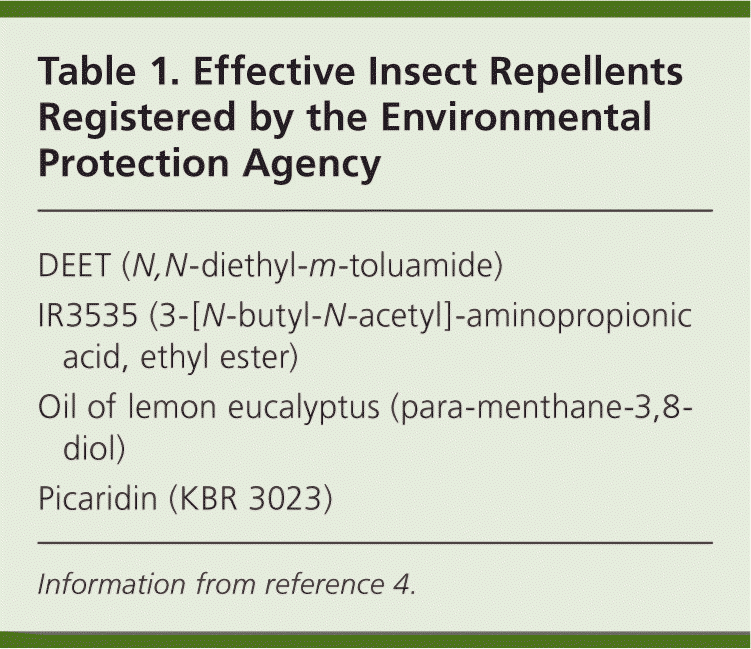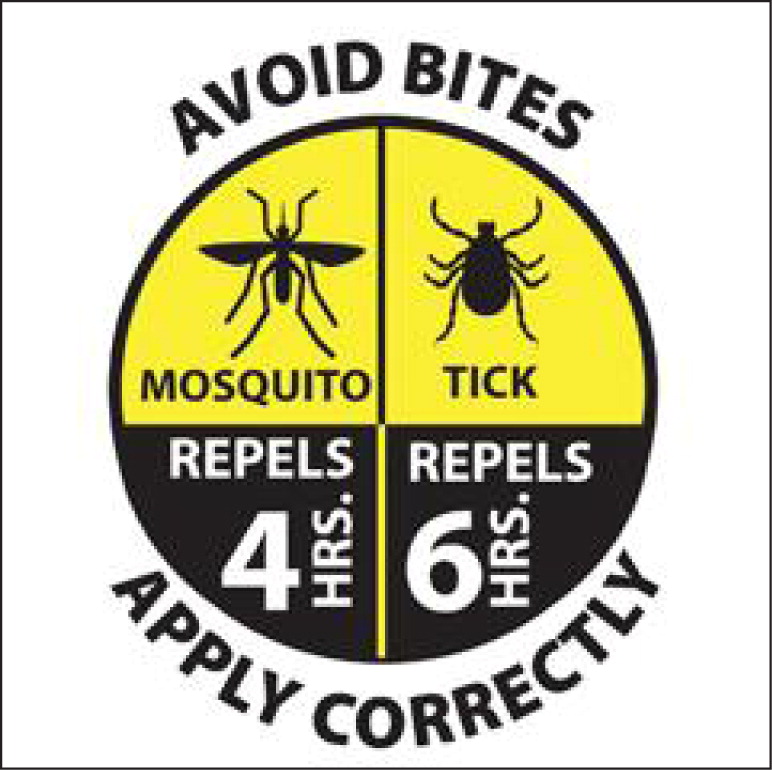
Am Fam Physician. 2015;91(11):754-755
Author disclosure: No relevant financial affiliations.
Emerging vector-borne diseases have become a concern for travelers and nontravelers alike. Although Ebola has dominated recent headlines, tropical arboviruses such as dengue and chikungunya have more quietly reached the United States. Local transmission of chikungunya virus was first documented in the United States in July 2014, and local spread of dengue has occurred in Florida, Texas, and Hawaii.1,2 West Nile virus was initially detected in the United States in 1999 and has since been found in every state in the continental United States.3 Furthermore, tick-borne diseases such as Lyme disease, southern tick-associated rash illness, and Rocky Mountain spotted fever are endemic to many parts of the country. The changing epidemiology of vector-borne diseases highlights the importance of personal protective measures, including the use of insect repellents. There are many myths and misperceptions about repellents, and there is increasing consumer interest in “natural” alternatives to conventional products. Therefore, family physicians should be knowledgeable about which products are effective and safe. Table 1 lists effective insect repellents registered by the Environmental Protection Agency (EPA).4

| DEET (N,N-diethyl-m-toluamide) |
| IR3535 (3-[N-butyl-N-acetyl]-aminopropionic acid, ethyl ester) |
| Oil of lemon eucalyptus (para-menthane-3,8-diol) |
| Picaridin (KBR 3023) |
N,N-diethyl-m-toluamide (DEET) is the first-line mosquito repellent, and numerous studies have demonstrated its effectiveness and safety.4,5 Repellents with 20% to 50% DEET provide up to several hours of protection (there is no significant increase in effectiveness with concentrations greater than 50%.) DEET-impregnated wristbands repel mosquitoes only from areas covered by the band, so their usefulness is limited. DEET is considered safe in the second and third trimesters of pregnancy and in children older than two months.4,5 It should be noted that it can damage plastics and synthetic materials; therefore, care should be taken when it is used around plastic watches, eyeglasses, and synthetic fabrics.
Effective alternatives to DEET include Picaridin (KBR 3023) and IR3535 (3-[N-butyl-N-acetyl]-aminopropionic acid, ethyl ester).4 Picaridin does not affect plastic or synthetic materials and is essentially odorless. IR3535 is available in the United States as Avon Skin-So-Soft Bug Guard Plus IR3535 lotion. Picaridin and IR3535 are generally considered safe in children and pregnant women.
There is growing interest in natural insect repellents, but most are not recommended because of lack of effectiveness.6 An exception is oil of lemon eucalyptus (p-menthane-3,8-diol), a plant-based repellent that has been shown to have effectiveness and duration of action comparable to DEET. It is the only plant-based repellent recommended by the Centers for Disease Control and Prevention,4 but should not be used by pregnant women or children younger than three years. Studies have also shown that a repellent combining 2% soybean oil with other oils and emollients protects against mosquitoes for 1.5 to 7.2 hours.5 This type of repellent is available in the United States as Bite Blocker but is not registered by the EPA as a repellent.
Citronella is a common ingredient in many natural repellents. However, citronella-based products at lower concentrations have a limited duration of action, and higher concentrations can cause skin irritation. Therefore, citronella may be acceptable for brief exposure to nuisance mosquitoes, but it is not advised for protection against disease-carrying mosquitoes. Essential oils have no effectiveness and are not recommended.
There is no evidence to support the use of novel devices such as electronic mosquito repellents.7 Likewise, there is no validity to the notion that ingesting garlic or B vitamins protects against mosquitoes.
Synthetic mosquito repellents also have some effectiveness against ticks; however, IR3535 provides the best protection against the Lyme vector Ixodes scapularis.8,9 Permethrin, a product originally derived from chrysanthemum flowers, has insecticidal and repellent properties and is highly effective against ticks, mosquitoes, and other arthropods. It is applied to clothing and other fabrics (e.g., nets, tents) and not on skin. Combining the use of permethrin on clothes with other repellents on exposed skin provides the best protection against biting arthropods.
Increased international travel and climate change will continue to influence the distribution of arthropods and the viruses they carry. Aedes aegypti, the vector for yellow fever and dengue, was found in Los Angeles County, Calif., for the first time in 2014.10 Consequently, the importance of using insect repellents has grown. The EPA recently introduced a repellency awareness graphic (Figure 1) to help consumers understand which insects the product protects against, as well as the duration of action of the product. It is anticipated that additional alternatives to traditional repellents will be developed, providing consumers with more options.

